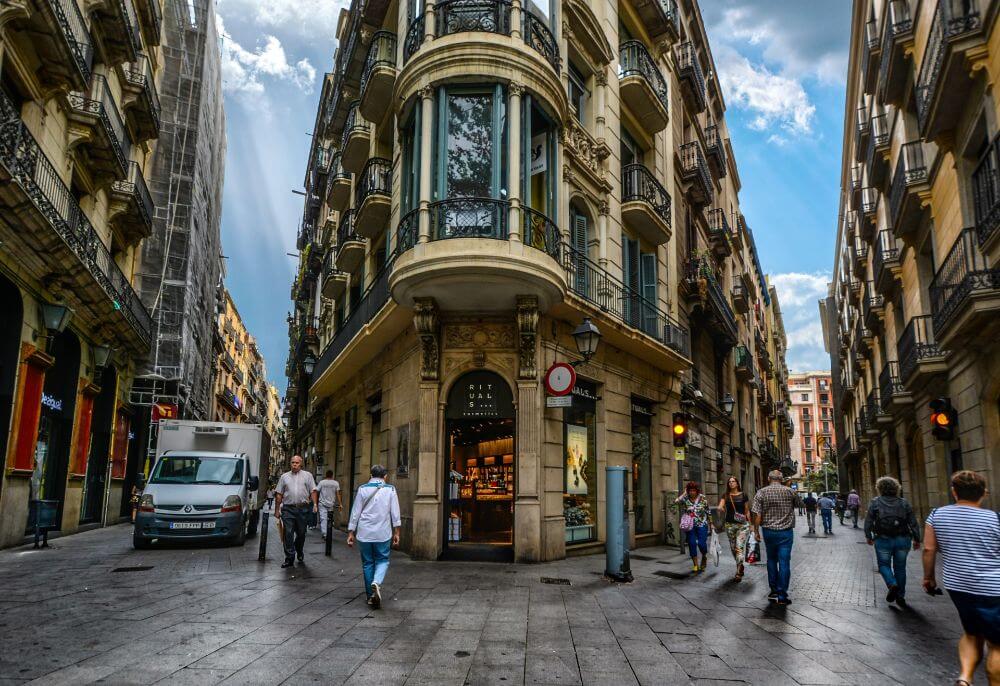Tickets & Tours – Gothic Quarter (Barri Gotic), Barcelona
To add more items, please delete some old ones.View wishlist
Top activities in Barcelona
Explore Barcelona and beyond
Trip Inspiration
- Overview
- Tours & Tickets
Walking Tours
Bus Tours
Sightseeing Tours
City Tours
Cultural Tours
Private and Luxury
Half-day Tours
Nature and Wildlife Tours
Nature Walks
Full-day Tours
Specials
Deals & Discounts
Free Cancellation
Likely to Sell Out
Skip-The-Line
Private Tour
Viator Exclusive
New on Viator
Filters
Frequently Asked Questions
The answers provided below are based on answers previously given by the tour provider to customers’ questions.
Q:
What’s the best way to experience Gothic Quarter (Barri Gotic)?
More Tours in Barcelona
- Art & Culture
- Audio Guides
- Classes & Workshops
- Food & Drink
- Kid-Friendly
- Likely To Sell Out
- Outdoor Activities
- Seasonal & Special Occasions
- Tickets & Passes
- Tours, Sightseeing & Cruises
- Travel & Transportation Services
- Unique Experiences
Things to do near Barcelona
- Things to do in Catalonia
- Things to do in Tarragona
- Things to do in Girona
- Things to do in Mallorca
- Things to do in Toulouse
- Things to do in Zaragoza
- Things to do in Ibiza
- Things to do in Montpellier
- Things to do in Valencia
- Things to do in Arles
- Things to do in Nîmes
- Things to do in Marseille
- Things to do in Avignon
- Things to do in Balearic Islands
- Things to do in Midi-Pyrénées
More attractions near Barcelona
- Barcelona City Hall (Casa de la Ciutat)
- St.
James Square (Plaça de Sant Jaume)
- Catalan Regional Government Building (Palau de la Generalitat de Catalunya)
- Temple of Augustus (Temple d’August)
- Barcelona City History Museum (MUHBA)
- Placa de Sant Felip Neri
- Frederic Mares Museum (Museu Frederic Mares)
- Barcelona Cathedral (Catedral de Barcelona)
- Ciutat Vella (Old Town)
- Basilica of Santa Maria del Pi
- George Orwell Square (Plaça de George Orwell)
- Hash Marihuana & Hemp Museum
- Placa del Rei
- European Museum of Modern Art (MEAM)
- Erotic Museum of Barcelona (Museu de l’Erotica)
Trending attractions
- Colosseum
- Eiffel Tower
- Hoover Dam
- Louvre
- Statue of Liberty
- Sagrada Familia
- Burj Khalifa
- Road to Hana (Hana Highway)
- Acropolis
- Roman Forum (Foro Romano)
- Molokini Crater
- St. Mark’s Basilica (Basilica di San Marco)
- Na Pali Coast
- Uffizi Galleries (Gallerie degli Uffizi)
- Great Barrier Reef
What To See and Do in Barcelona’s Gothic Quarter
-
Facebook
-
Twitter
Here’s my guide to the Gothic Quarter of Barcelona Spain.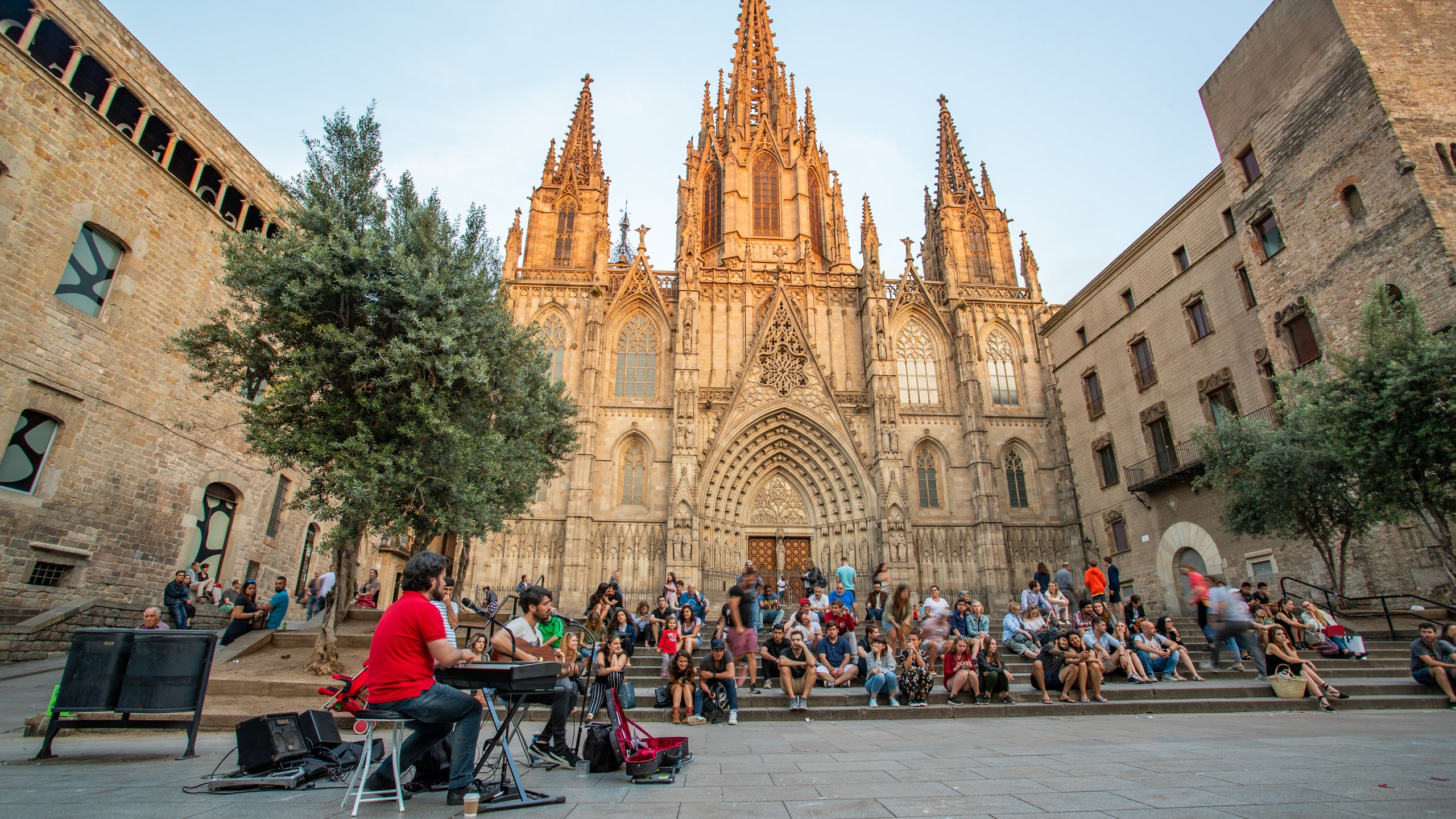
The Gothic Quarter, Barrio Gotic, is the delicious center of Barcelona’s old town. It should definitely be on your itinerary for Barcelona.
ancient Roman Gate and Placa Nova in the Gothic Quarter
The Gothic Quarter is the heart of Barcelona, an evocative and mysterious place. It’s a bustling labyrinthian maze, a warren of dark narrow streets that wind between stone buildings linking squares large and small.
The Gothic Quarter is home to Roman ruins, medieval monuments, beautiful churches, and cobbled lanes. There’s no shortage of eye candy.
The Gothic Quarter is Barcelona’s birthplace. It used to be the Roman village of Barcino. Barcelona was enclosed within protective walls until the 1850s.
Later, the Gothic Quarter was an enclave frequented by artists like Picasso, Dali, Miro, and Antoni Gaudi. Though it has plenty of ancient buildings and just drips in Gothic, some Neo-Gothic elements were added in the 19th century.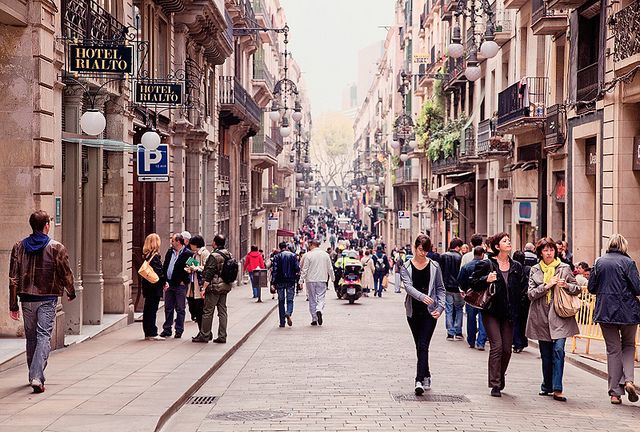
The Gothic Quarter is located between La Rambla and the Via Laietana. You can get there via Metro Line 3 Liceu station or Metro Line 4 Jaume I Station.
You might want to have a paper map, as sometimes it’s difficult to get GPS signals. But getting lost in the Gothic Quarter is a quintessential Barcelona experience.
Pla de la Seu with Barcelona Cathedral
Here are my picks for the best things to do and see in and around Barcelona’s Gothic Quarter.
You can book a small group guided walking tour of the Gothic Quarter or your own private tour of the neighborhood. This are is also a good area to go on an evening tapas tour.
1. Barcelona Cathedral
The Gothic Quarter begins at the Pla de la Seu. There, street magicians and human statues panhandle in front of Barcelona Cathedral.
The cathedral is a top attraction in the Gothic Quarter. It’s a grand monument dating from the 13th to 15th centuries.
The cathedral’s Neo-Gothic facade is stunning. It’s not ancient, receiving facelifts in the 19th and 20th century.
Sit by the steps and absorb its grandiosity. You can visit the church for free from 8:00 am to 12:45 pm and 5:45 pm to 7:30 pm. Otherwise, entry is by donation.
interior nave of Barcelona Cathedral
Inside, the cathedral has a wide central nave and two side aisles, separated by colonnades. The cathedral has 28 richly decorated chapels, an ornate finely carved choir, and a peaceful cloister with bubbling fountains.
Behind the high altar is the Bishop’s chair. You’ll also find the crypt of Saint Eulalia, the patron saint to whom the cathedral is dedicated.
The cloisters are the highlight. Arcaded walkways surround a central courtyard filled with tropical trees. A short elevator ride takes you to the top of the cathedral for stunning city views. For the best view of cathedral itself, take the elevator to the rooftop of the next door Hotel Colon.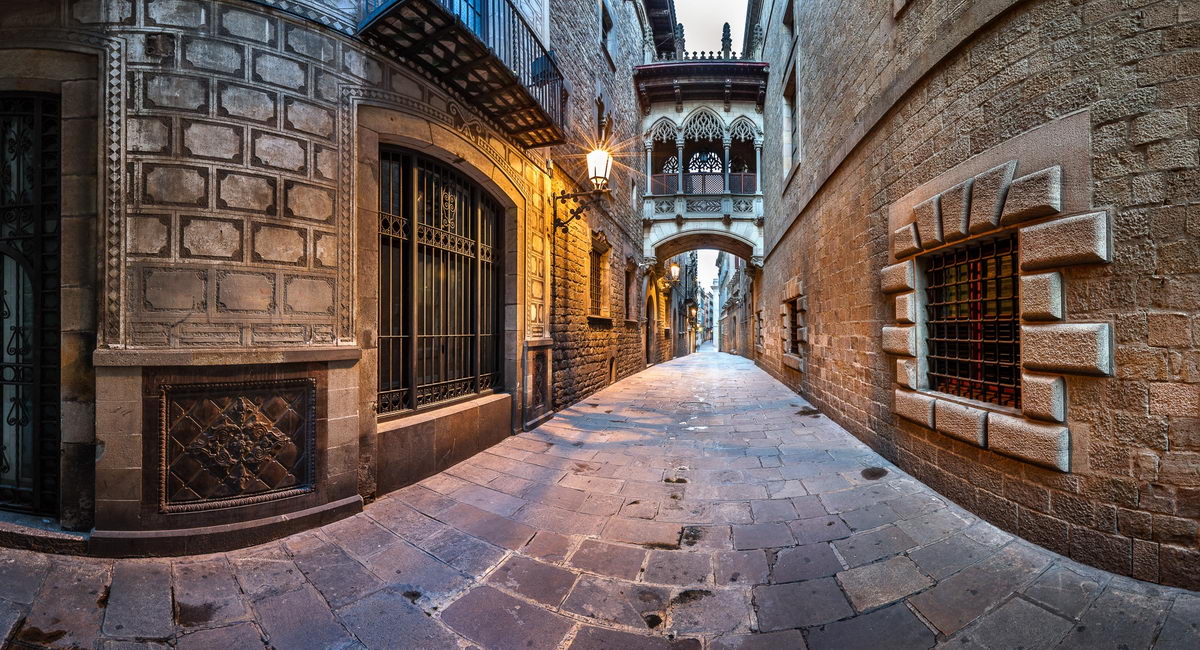
Address: Pla de la Seu
Pro Tip: A dress code is strictly enforced. No tank tops or shorts or skirts above the knee.
Basilica of Santa Maria del Mar
2. Basilica of Santa Maria del Mar
Another top attraction in th Gothic Quarter is the beautiful basilica of St. Mary of the Sea. It’s tucked away in the El Born neighborhood.
The basilica is really one of the jewels of the historic center. With roots tracing back to Roman times, the 4th century church is one of the finest surviving examples of Catalan Gothic architecture.
On the exterior, the church has three facades and two symmetrical towers. Because the area is rather claustrophobic, it can be hard to get a full view. The round rose window is considered one of the largest in the world.
Inside, the church has a light and airy feel, with many stained glass windows. You’ll also see beautiful Gothic arches, a monumental altar, and other decorations.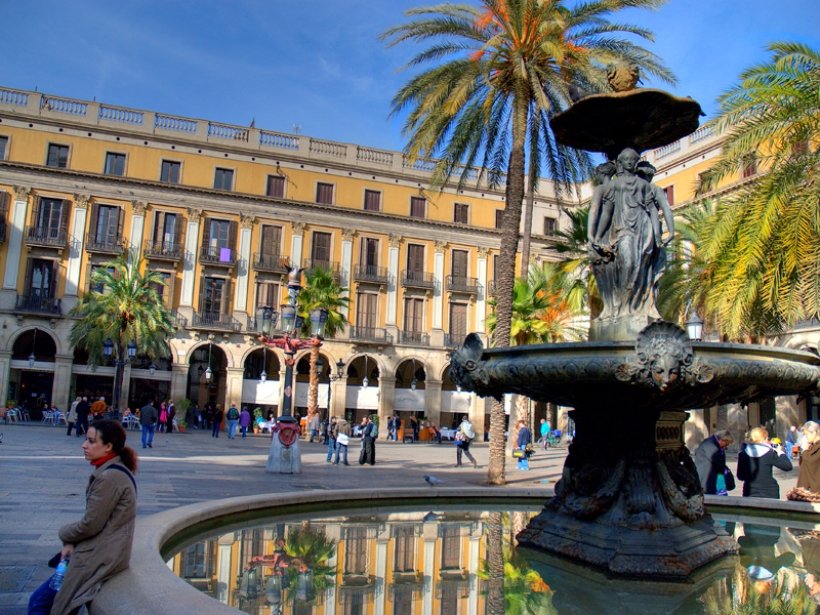
The church is free for self-guided visits. If you spend a few euros for a guided tour, you’ll have access to the church’s three amazing terraces, with breathtaking views. There’s also a longer tour at dusk, where you can visit at a more leisurely pace without crowds.
Address: Placa de Santa Maria, 1
the Picasso Museum, set amidst medieval palaces
3. Picasso Museum
The setting of the Picasso Museum is stunning. If you’re an art lover (or even ifyoure’ not), the museum is a must visit destination in the Gothic Quarter.
It’s lodged in five adjoining medieval stone mansions in Barcelona’s funky-chic El Born neighborhood, with a gorgeous terrace. The palaces date from the 13th to 14th centuries, and are characteristic of the Catalan civic Gothic style.
READ: Guide To Picasso Museums in Europe
Founded in 1963, the museum was launched with a donation of 574 works by Picasso’s secretary, Jaime Sabartes.
For Picasso, Barcelona was where it all began. He lived in Barcelona during his early apprenticeship. Barcelona is where he wanted his namesake museum.
Picasso, Science and Charity, 1897
At the museum, you can enjoy an extensive collection of Picasso’s work, certainly the best collection in Spain. There’s over 3,000 pieces, mostly from Picasso’s formative years in Barcelona.
By experiencing his youthful works, you can better understand his later abstract pieces and how he became the greatest artist of the 20th century. To further this cause, the museum is arranged chronologically with good descriptions.
Click here for a skip the line 1.5 hour guided tour of the Picasso Museum. If you love Picasso, you can also book a Picasso-themed tour of the city.
Address: Carrer de Montcada, 15-23
Placa Reial
4. Placa Reial
The 19th century Place Reial, or Royal Square, is one of Barcelona’s ancient and beautifully designed squares.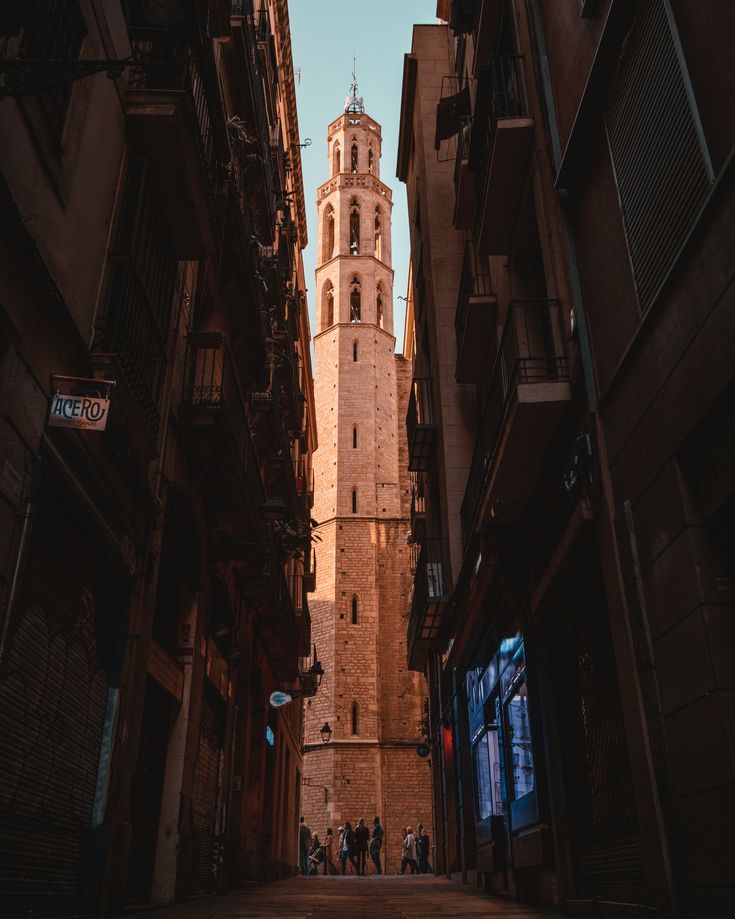
It’s a lively pedestrianized hangout spot. During the day, visitors laze in the square or indulge at the many tapas restaurants.
Placa Reial has charming yellow buildings with Neo-Classical pillars and uniform archways. It’s dotted with iron lampposts and palm trees. The square was the work of architect Daniel Molina, completed in 1848.
Placa ReialGaudi-designed lamps
In the center is the classically designed Fountain of Three Graces, by architect Antoni Rovira i Trias.
The graces represent charm, beauty, and creativity. The Modernist lampposts were Gaudi’s first government sponsored project. The six-armed lamps are topped by whimsical winged helmets.
Placa Reial is an excellent place to start your stroll in the Gothic Quarter because it’s just off La Rambla.
READ: Guide to Modernist Architecture in the Eixample Neighborhood
the parabolic arch entrance to the Gaudi-designed Palau Guell
5.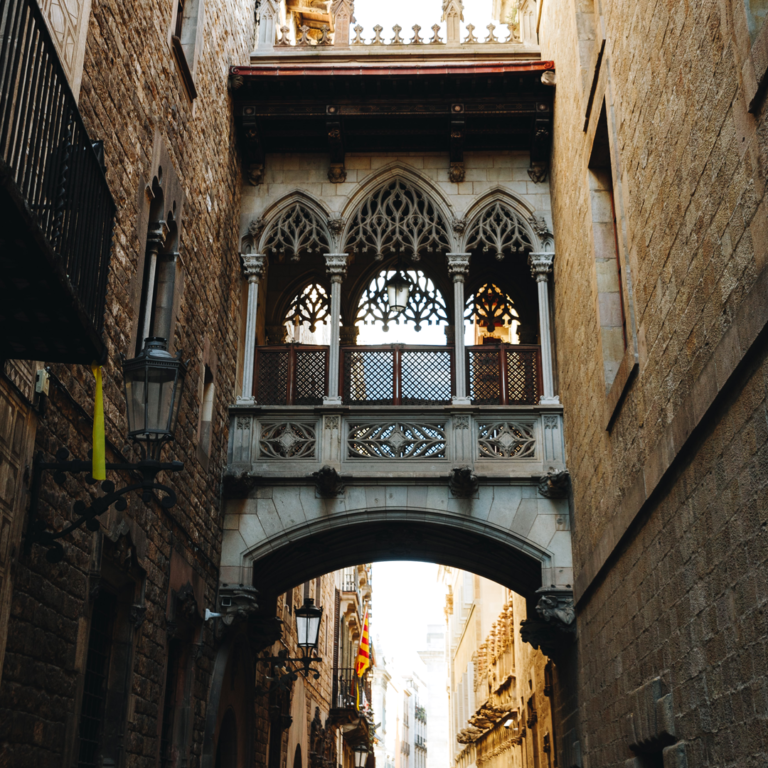
Located off La Rambla in the El Raval neighborhood is Palau Güell, or Güell Palace. The mansion doesn’t immediately scream Gaudi.
It’s more traditional and dark, almost like a luxurious Venetian palace. It has a creepy Gothic vibe. And I mean that in a good way. Don’t miss this wondrous UNESCO-listed building.
The Palau Güell commission came at the outset of Gaudi’s career, when he was establishing himself as an architect. Built between 1886-88, it was designed for Eusebi Guell.
He was a prominent industrialist and Gaudi’s greatest patron. It was the family’s residence until they moved to Park Güell in 1910. The original period furniture is still in place.
The restored interior is exquisitely curvy. The home centers on a monumental three story main room that was used to entertain wealthy guests. It has a high ceiling crowned by a parabolic dome, covered in cobalt honeycomb tiles.
atrium on the main floor of Palau Guellceiling inside Palau Guellwhimsical roof of Palau Guellchimneys of Palau Guell
Small holes are perforated near the top.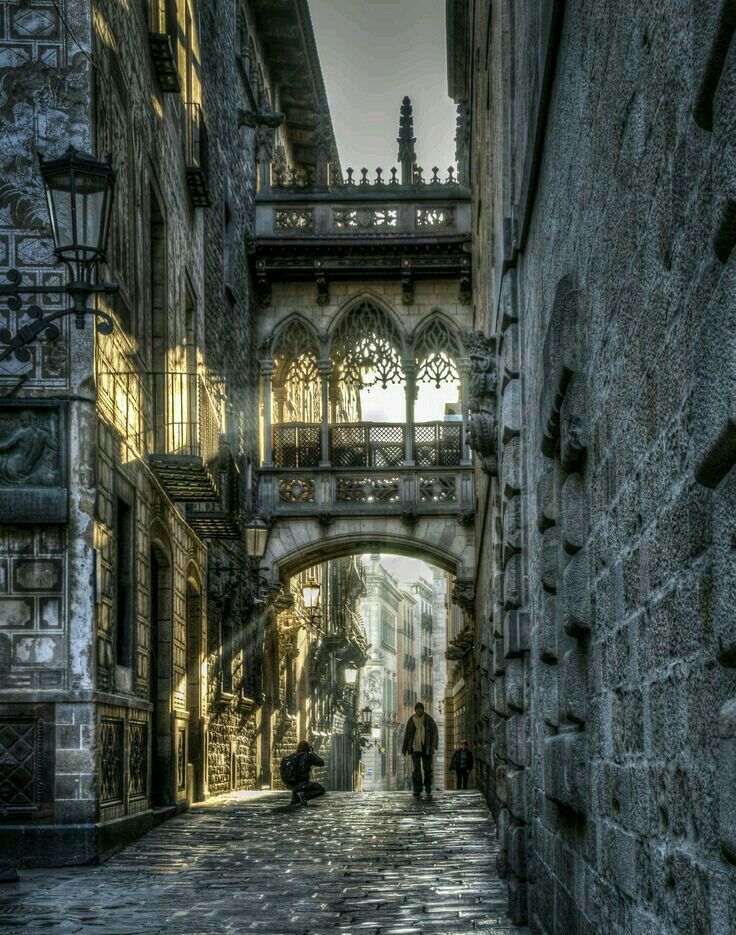
Most of Gaudi’s experimentation is in the basement, which was used as a horse stable. It reflects Gaudi’s early enthusiasm for using natural shapes, with vaulted pillars in the form of mushrooms.
The loopy rainbow roof, like many Gaudi creations, also features colorful ceramic shapes and 20 chimneys. One conical chimney looks like a stack of green olives smooshed together. Gaudi tended to put his most innovative work in the top and bottom of buildings to avoid the ire of his clients.
Address: Carrer Nou de la Rambla, 3-5
Casa Marti, which houses the restaurant Quatre Gat
6. Els Quatre Gats
Els Quatre Gats is a famous tapas restaurant and bar housed in a beautiful Modernist building, Casa Marti.
It was designed by Josep Puig i Cadalfach, one of the greatest architects of the era. The bar was conceived as the Spanish equivalent to Paris’ Le Chat Noir cabaret hall.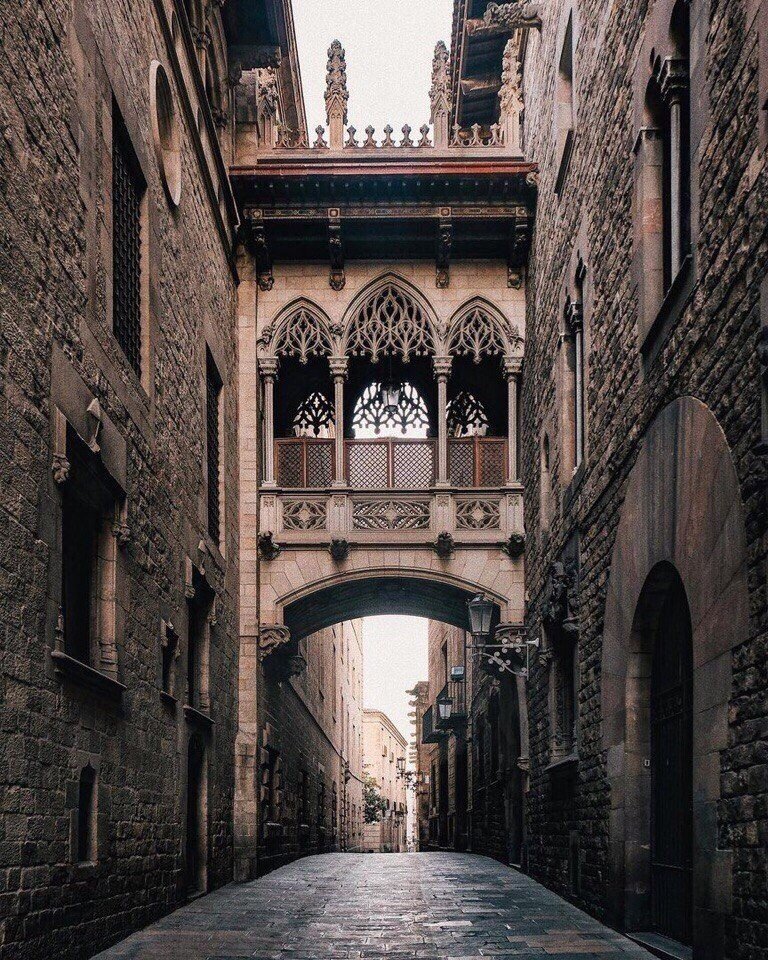
READ: Guide to Architecture in Barcelona’s Eixample Neighborhood
Els Quatre Gats was embraced straight away by the Barcelona bohemians. A young Picasso frequented the place, and hosted his first one man show there in 1900. Antoni Gaudi was also a regular customer.
The interior is trapped in time, a time capsule of a bygone era. It has black and white portraits and sketches by Picasso. But prices have risen and tourists have replaced the former artsy crowd.
Address: Carrer de Montsio, 3
Joan Fontcubertat, The World Begins With Every Kiss, 2014
7. Street Art
The Gothic Quarter is home to some of Barcelona’s finest street art. It makes the Gothic Quarter a fascinating blend of old and new, with art alive on the streets.
Be sure to see the 26 foot long The World Begins With Every Kiss mural near the cathedral.
Created by Catalan artist and photographer Joan Fontcubertat, the mural was unveiled in 2014.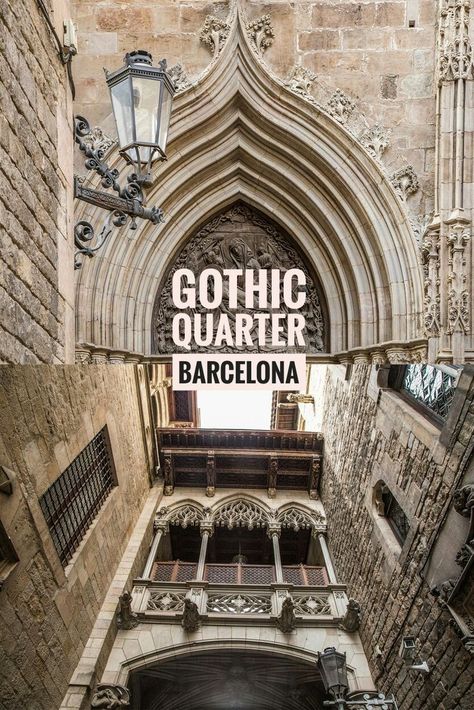
The photographer asked locals to send in photographs that expressed a moment of freedom. The photographs were placed on tiles and arranged in a mural. From afar, the arrangement looks like a poignant (or perhaps erotic) kiss. Up close, you see a world in each image.
Address: Placa d’Isidre Nonell
Miro tribute mural. Image @ Marta Nimeva Nimevienestreet art in El Raval
A favorite playground of street artists is Three Chimneys, an urban park built specially for street art. There’s a long wall that artists can paint on with fear of fine.
Another iconic mural is a tribute to artist Joan Miro. You’ll find it on the corner of Carrer de Sant Pau and Carrer de la Riereta. Created by Sixe Paredes, it has Miro’s characteristic playful colors and shapes.
The trendy El Raval neighborhood is also home to plenty of street art and graffiti. You’ll find a mishmash of large murals, small installations, and ever-changing street art.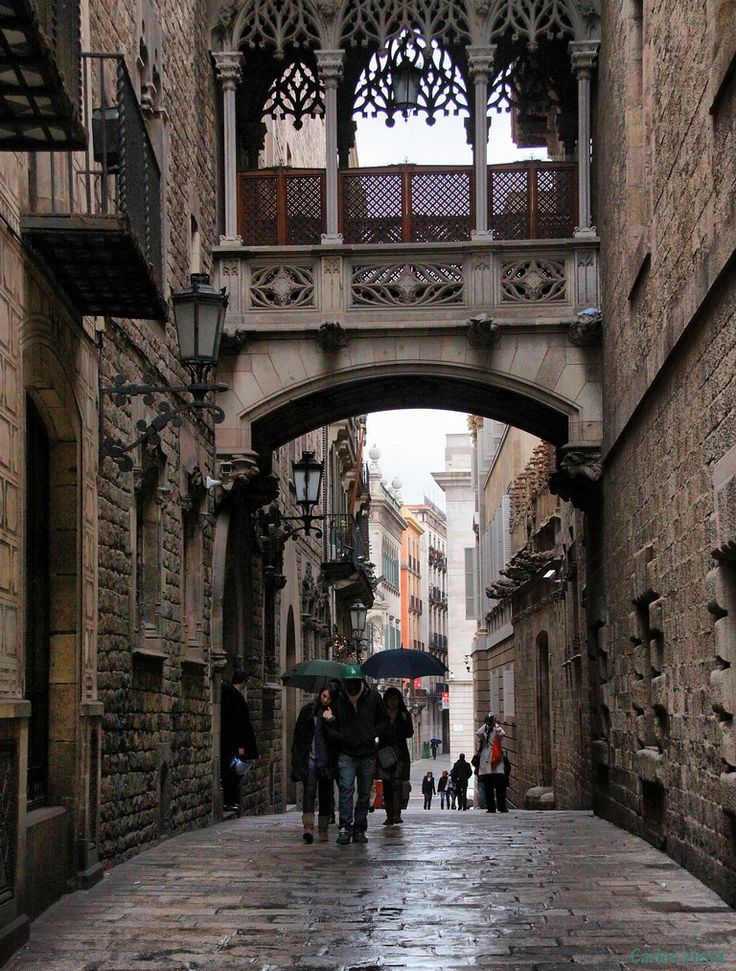
The Barcelona Museum of Contemporary Art in the Placa dels Angels, has a long wall painting by the famed Keith Haring. The square is also decorated with street art.
Bridge Carrer del Bisbe in the Gothic Quarter
8. Puerta del Bisbe | The Bishop’s Bridge
This might be the most famous spot in the Gothic Quarter. The Bishop’s Bridge isn’t technically a bridge.
It’s a covered gallery connecting the Government Palace and the Canon’s House. The Neo-Gothic bridge itself isn’t terribly old, though it blends in well with its frilly stonework and gargoyles.
It was built in 1928 for the Barcelona International Exposition by architect Joan Rubio i Bellver. He aimed to build a series of similar bridges, but his project was nixed by the government.
A bit pissed off, he incorporated a hidden skull with a dagger on the bridge’s underside, which has generated myths.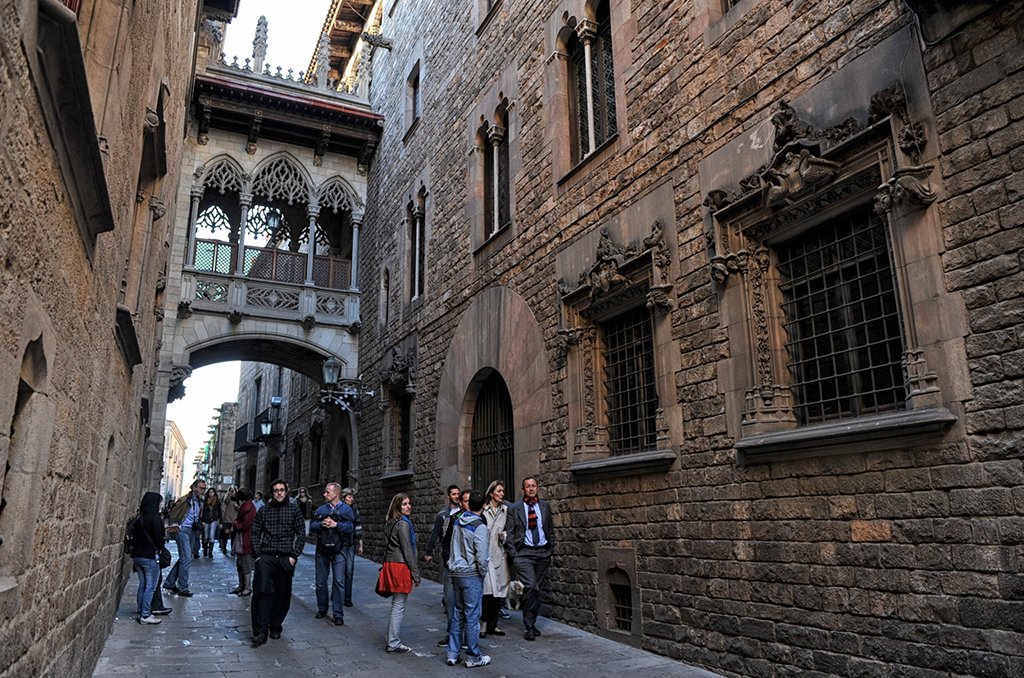
underside of the Bishop’s Bridge
One legend holds that if you make a wish when you pass under the bridge, while looking at the skull at its base, your wish will come true. Another holds that, if you see the skull, you’ll fall pray to an evil spell.
In the 4th century, Barcelona was originally protected by four fortified walls. One such ancient turret can be glimpsed at the Puerta del Bisbe.
Immediately past the bridge is a facade with the Statue of Saint Jordi. It was carved by Pere Johan in the 15th century. Jordi was a legendary Catalonian knight who valiantly rescued a princess from a dragon.
When Jordi slew the dragon, a rose bush grew. Jordi gifted his love a rose. Now, on April 23, lovers celebrate St. Jordi’s day with an exchange of a rose or gift.
Address: Carrer del Bisbe
ornate facade with sgraffito decorations, in the Placa del Pi
9. Plaza del Pi
This tiny square is the perfect getaway from Barcelona’s hurly burly.
Named the Square of Pines, the main attraction is the Church of Santa Maria del Pi. It’s a 14th century Catalan Gothic church, famous for its rose window. Much of it was gutted by a fire during the Spanish Civil War in 1936.
You can climb the bell tower for views. And there are frequent evening concerts inside the church.
The Plaza del Pi is surrounded by ornate facades, antique shops, and cafes. It’s also renowned for its artisanal food market held the first and third Friday, Saturday, and Sunday of the month.
allegory of justice mailbox designed by Montaner
10. The Mailbox and the Magic Turtle
Another attraction is a small Modernist style mailbox on the facade of the House of the Archdeacon. It’s actually free to enter this building. You can climb the balcony in the courtyard for views of the Barcelona Cathedral.
To the right of the doorway is a mailbox designed by Lluis Domenech i Montaner, for the local lawyers association.
Swallows represent the transcendency of justice. Ivy represents the tangled bureaucracy confronting lawyers. And the turtle suggests the grindingly slow pace of the judicial system.
Be sure to touch the turtle. Legend holds it will be will cure you any evil spell you might have been infected with by the skull and dagger at the Bishop’s Bridge
Address: Carrer de Santa Llucia, 1
the four remaining columns of the ancient Temple of Augustus
11. Temple of Augustus
The Gothic Quarter is home to Barcelona’s most ancient hidden treasure. It’s a Roman temple, dating from the 1st century B.C., hidden behind the cathedral.
It’s just off Placa Sant Jaume on Carrer del Paradis. An ancient sign announces the improbable temple.
Emperor Tiberius built the Temple of Augustus to honor his stepfather Emperor Augustus. The temple was intended as a focal point of a Roman forum.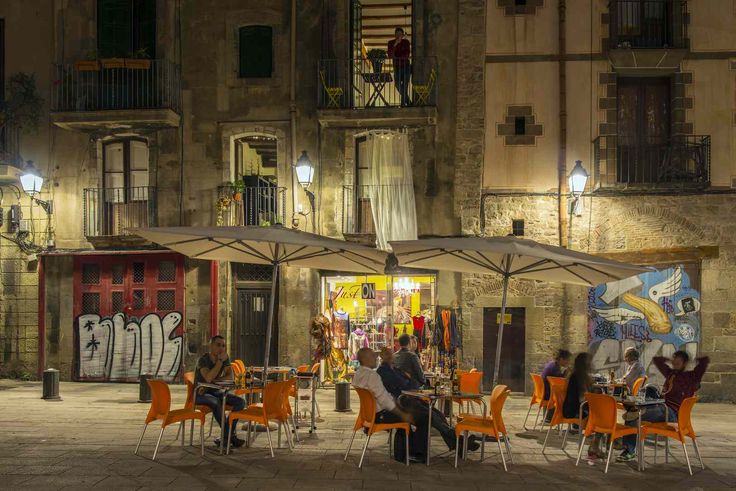
Now, in a courtyard, you’ll find four 30 foot tall ancient Roman Corinthian columns, which somehow survived 2,000 years. Dating from the first century B.C., they were part of ancient Barcelona’s biggest structure — a 120 foot long temple that extended from the temple to Barcino’s forum.
Address: Carrer del Paradis
an ancient Roman Gate and Placa Nova in the Gothic Quarter
12. Placa Nova
In Placa Nova, you’ll find two circular Roman towers flank Bisbe Gate on the main street. These were once the monumental entryways to the Roman city of Barcino. The city’s name may have come from the Roman general Barca.
Historians and archaeologists estimate that, at the Roman village of Barcino’s peak, the Roman city walls were 25 feet high with 74 towers.
In 1994, the sculpture Barcino by Joan Brossa was installed in the square.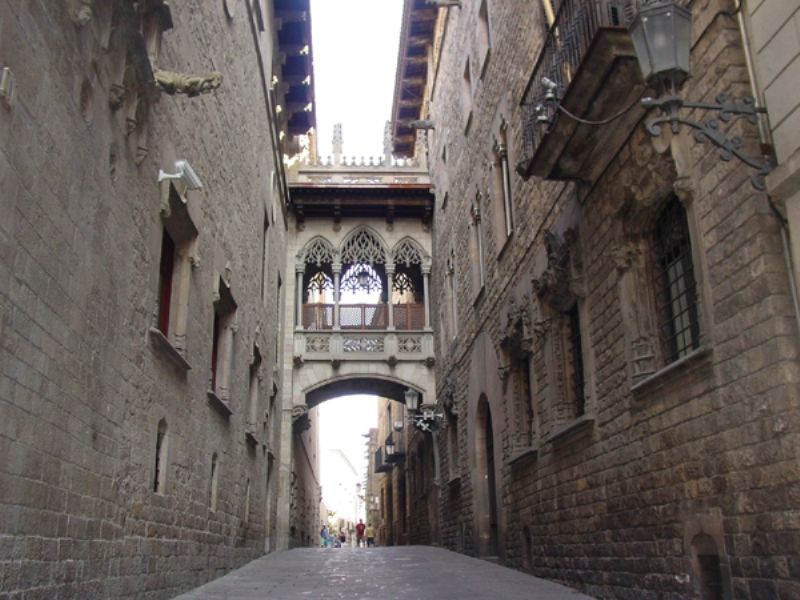
On the other side of Placa Nova lies the Architects’ Association. There are a series of sand friezes around the facade with scribblings designed by Pablo Picasso.
On the weekends, a market pops up in the square. Perhaps you can discover an antique or souvenir from Catalonia.
Placa de Sant Jaume
13. Placa de Sant Jaume
Placa de Sant Jaume is a stately square smack in center of the Gothic Quarter. Its name derives from the Church of St. James that formerly stood there. The square was once a Roman forum.
The black-bricked square houses two important government buildings — the Palau de la Generalitat and the Barcelona City Hall.
The Generalitat is closed to the public. But city hall houses the tourist office. You should go in and gape at the great Gothic staircase and sculptures dotting the interior.
Placa de Sant Jaume has some beautiful wrought iron lamps.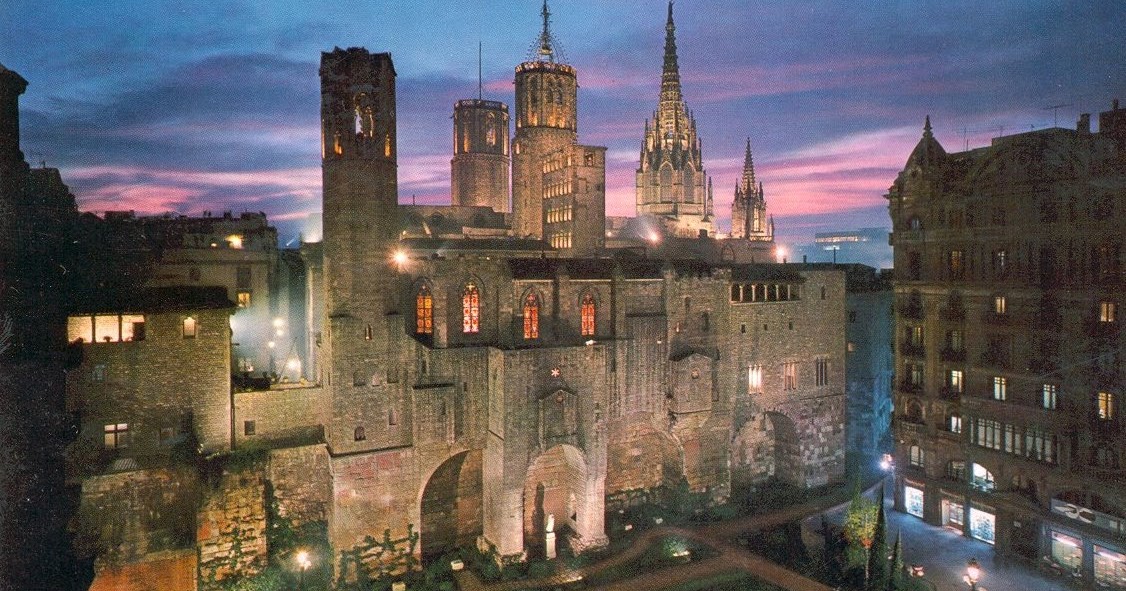
All main roads in Barcelona cross the plaza. Carrer de Ferran, which branches off the square, is a classic Barcelona thoroughfare.
the Barcelona History Museum in Placa del Rei
14. Museum of the History of Barcelona
In an unassuming building for the Gothic Quarter, you’ll find the delightful Museum of the History of Barcelona. The museum is Barcelona’s principal Roman-themed museum, and shares space with the former Royal Palace.
It’s believed to stand in a medieval courtyard once used by King Ferdinand and Queen Isabella to celebrate the return of Christopher Columbus.
Grab the essential audio guide and get ready for a listen. There are also English handouts. It’s best to start with a short introductory video in the theater.
In the basement level, the museum really comes to life. Down a special elevator, you’ll come to what seems like a mysterious underground labyrinth.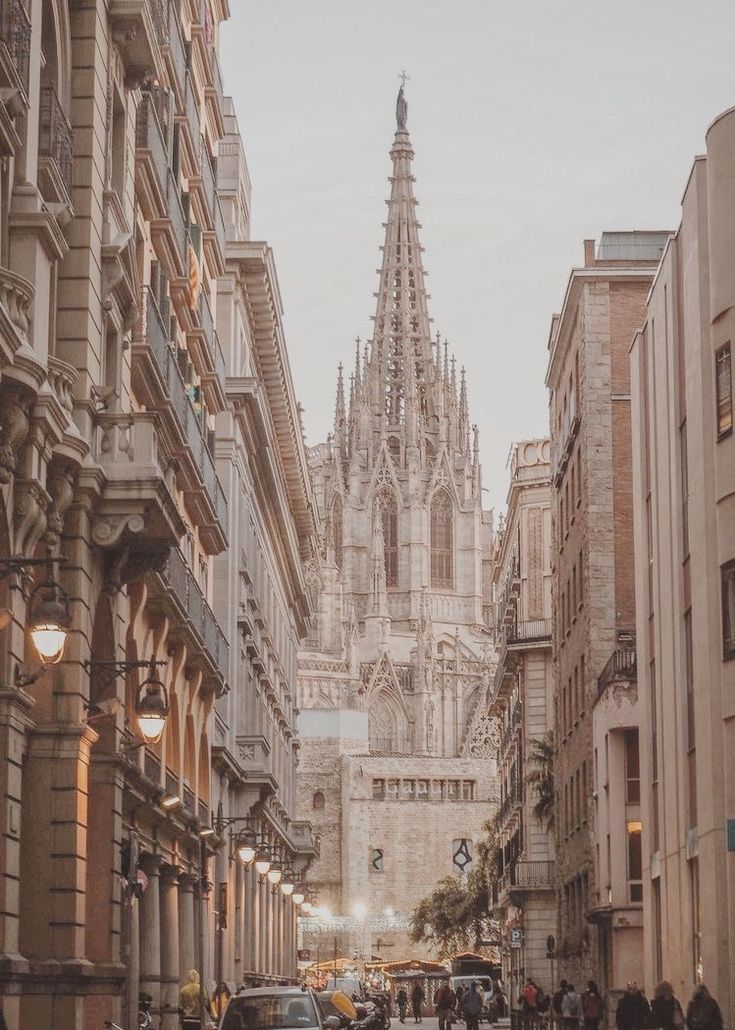
There, you’ll find Roman ruins dating from the time of Emperor Augustus — wall fragments, pavements, Roman baths, and even an ancient sewage system.
Address: Placa del Rei
Royal palace and statue of Ramon Berenguer
15. Palau Reial Major in Placa del Rei
The Palau Reial Major rises up at the back of the Placa del Rei, with the octagonal Watchtower of King Marti on one side. Palau Reial Major is part of the long history of Barcelona.
It’s a complex of three historic buildings that once served as the residence of successive counts and kings in the 13th to 15th centuries.
The three buildings are the Salon of Tinell (great hall), the palatine Chapel of St. Agatha (royal chapel), and the Lieutenant’s Palace (viceroy’s residence with a lovely garden). You’ll see traces of Visigoth and Romanesque features.
This is where you’ll see the famous steps on which Columbus met Queen Isabella. You can visit the Royal Palace as part of your visit to the Barcelona History Museum.
Address: Carrer dels Comtes
the incredibly beautiful auditorium of Palau de la Musica
16. Palau de la Musica
Perhaps Barcelona’s most beautiful and photogenic spot is the UNESCO-listed Palau de la Musica Catalana. The palace is a gaudy rose-covered wonderland.
It’s a magnificent concert hall designed in 1905-08 by Lluis Domenech i Montaner — an architect who was just as famous as Gaudi at the time.
You have to see it to believe it. Musicians love its acoustics. Tourists love its unique design. It’s a veritable symphony of stained glass, mosaics, and sculptures.
Palau de la Musica is located along a claustrophobic, densely packed street in the Gothic Quarter. Montaner countered the claustrophobia with color and levity. The arches and intricate mosaic adorned pillars draw your eye to the roofline. Stained glass windows bring in the natural light.
mosaic columns on the exteriorsculpture on the exteriorRigault stained glass dome
But the beautiful mosaicked facade is upstaged by the interior.
The piece de resistance is the intricate stained glass ceiling by Antoni Rigalt. Iron and glass chandeliers create a starry night effect.
And sculptures curve up the sides of the stage, including a glowering Beethoven and wind blown Valkeries from Richard Wagner’s operas.
Click here to pre-book a ticket to Palau de la Musica. Click here to book a 1 hour guided tour.
Address: Palau de la Musica, 4-6
the colorful roof of Santa Caterina Market
17. Santa Caterina Market
If you’re a foodie who can’t stomach elbowing your way through over-crowded La Boqueria on La Rambla, a great alternative is Mercat de Sant Caterina on the edge of the El Born district. The eye catching market hall is another piece of outstanding architecture in Barcelona, with 100 stalls on three levels.
Seven years in the making and debuting in 2005, Santa Caterina’s defining feature is its theatrical Gaudi-inspired roof.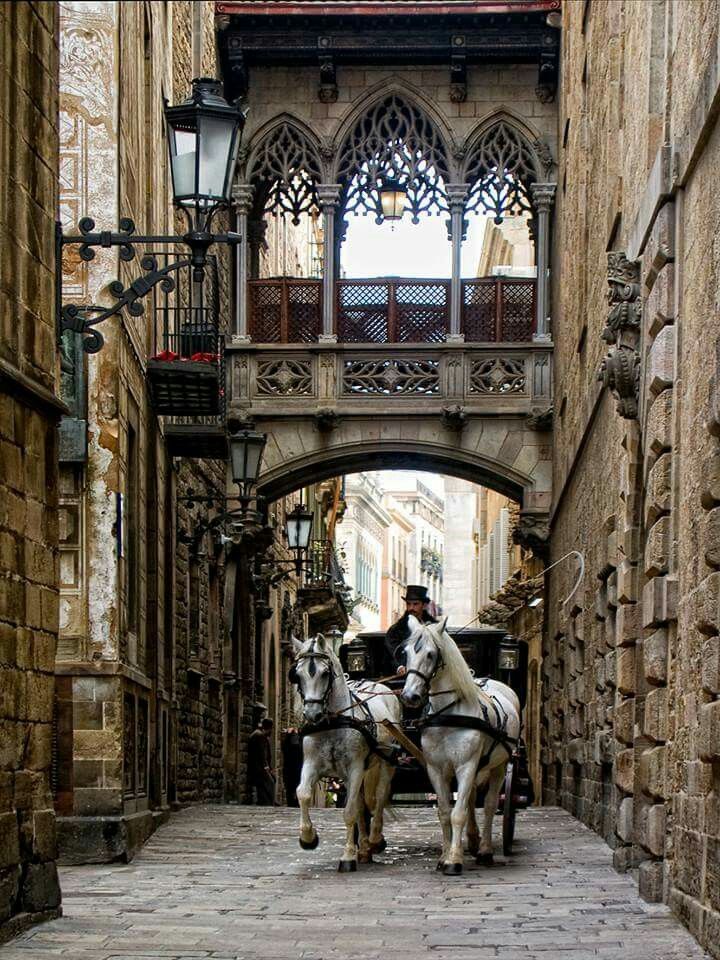
It was designed by the husband and wife team of Enric Miralles and Benedeta Tagliabue, who are famous for their promiscuously expensive projects.
Computer wizardry helped design the form of the roof. But the individual tiles had to be cut by hand.
This makes the market design both ultra modern and old in spirit and technique. The latter seems befitting since the market is right near Barcelona Cathedral and Santa Maria del Mar.
Address: Av. de Francesc Cambo, 16
crowds at La Boqueria
18. La Boqueria Market
About halfway down Las Ramblas is the legendary 19th century food market, La Boqueria.
It’s Barcelona’s beating heart, evolving from a rough and tumble purveyor of goods to a bona fide foodie destination.
The market is well worth checking out, especially if you need fresh fruit juice or a smoothie.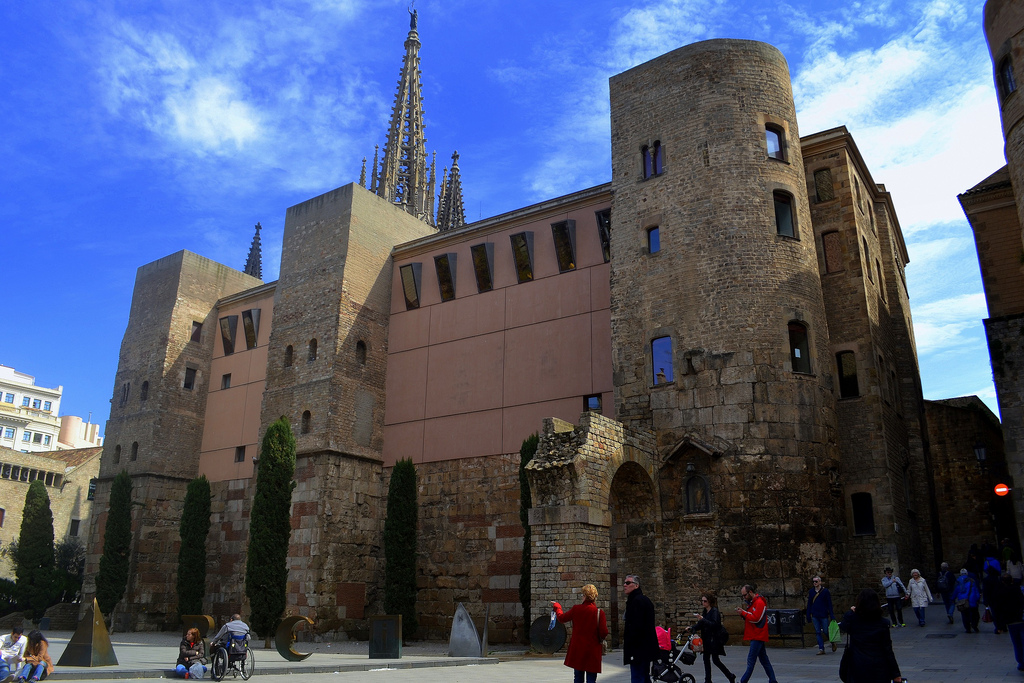
You can book a food and market tour, which includes Boqueria.
Aristide Maillol, The Mediterranean, 1905 — in the Frederic Mares Museum
19. Frederic Mares Museum
Next to Barcelona Cathedral is the Frederic Mares Museum. This delightful small museum houses the weird collection of local sculptor Frederic Mares.
Mares was a packrat collector and horder. There’s an entire floor dedicated to his curiosities — jewelry, ladies’ fans, keys, clocks, glasses, etc.
Mares collected a priceless variety of Spanish sculptures throughout his life, ranging from the ancient world to 19th century Catalonian pieces.
You’ll find plenty of Roman statues and a veritable warehouse of Romanesque and Christian art (especially crucifixes). The museum experience is tantamount to perusing a thrift shop or flea market.
The museum also has a zen courtyard with orange trees.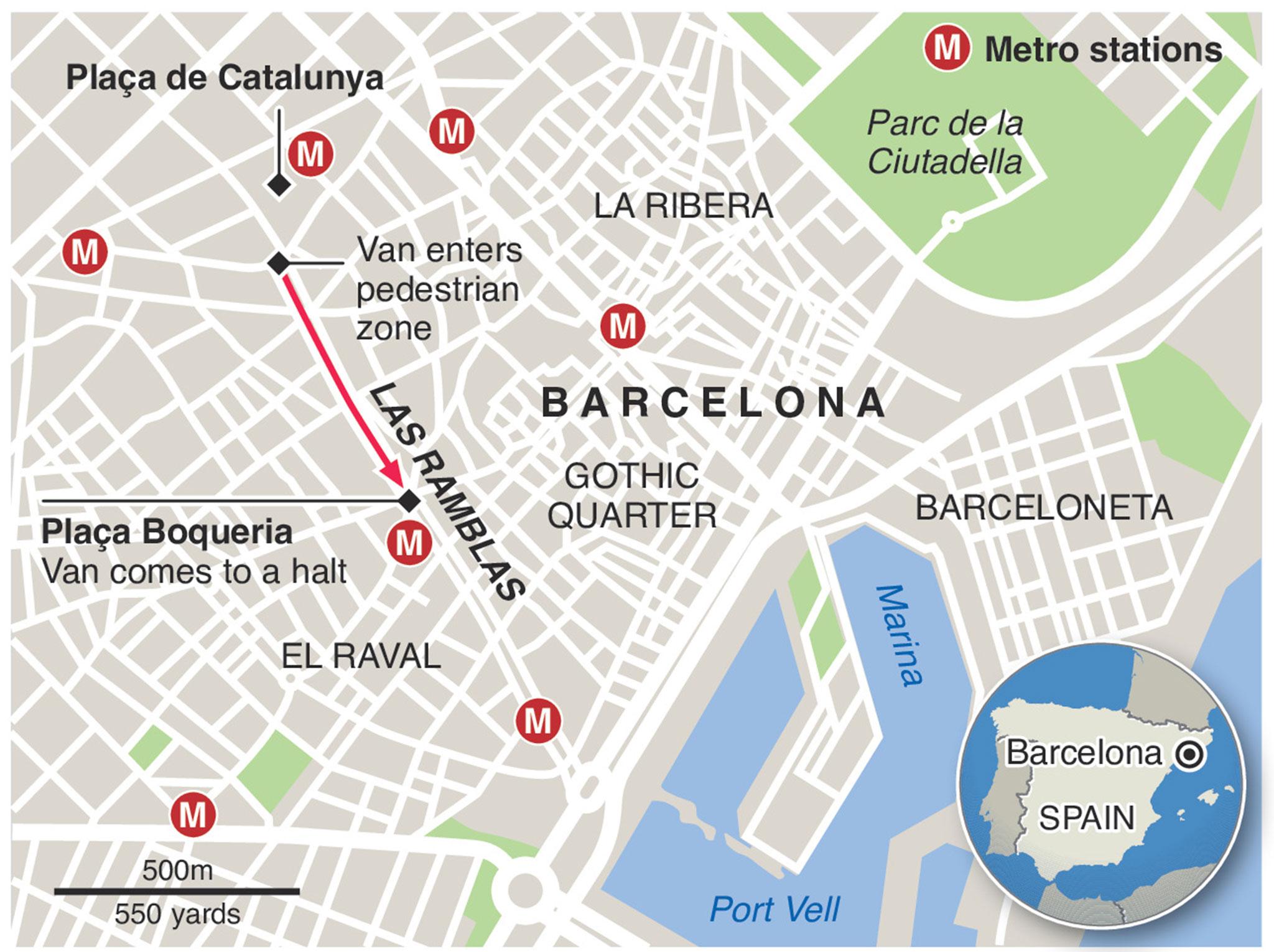
Address: Placa de Sant Iu, 5
pockmarked church in the Placa de Sant Felip Neri
20. Placa de Sant Felip Neri
Placa de Sant Felip Neri is a romantic quaint square in the Gothic quarter, a hidden gem in Barcelona. But, although it’s a pretty spot, it has a tragic past.
In 1926, the famous Catalan architect Antoni Gaudi was struck by a tram in the square. He died two days later in hospital.
During the Spanish Civil War, 42 people hid in the cellars of the square’s Baroque church, the Church of St. Phillipe Neri.
A 1938 bomb from Franco’s troops exploded there and killed everyone. Today, the pockmarked church still bears scars from the genocidal bombardment and is a silent reminder of that tragedy.
Gaudi Exhibition Center
21. Gaudi Exhibition Center
The Gaudi Exhibition Center is situated in the medieval Casa de la Pia Almoina.
The small museum has 1,000 square meters of exhibition space, distributed over three floors. The exhibits showcase the life and work of the Catalan architect and genius Antoni Gaudi. If you’re a Gaudi fan, the Gaudi Exhibition Center is a must do activity.
You can discover Gaudi’s influences and legacy through a video introduction, an interactive virtual reality exhibit, audiovisuals, multimedia content, holograms, designed sets, scale models, and documents. There are models of Casa Batllo, La Pedrera, the crypt at Colonia Guell, and even a replica of the iconic El Drac (dragon mosaic sculpture) from Park Guell.
You should come here before visiting Gaudi’s more famous Modernist works in the Eixample district. And, if you can’t get tickets to those popular sites, this museum serves as a substitute.
Please note the center is closed at the moment.
Address: Pla de la Seu, 7 (in front of the cathedral)
street in the El Raval neighborhood of the Gothic Quarter
Where To Stay In The Gothic Quarter
The h20 Madison is a hip luxe hotel with a rooftop pool.
The Ohla Hotel is a beautiful boutique hotel that’s luxurious and stylishly decorated. The h20 Cubik is a stylish modern hotel and a rooftop terrace with stunning views.
I hope you’ve enjoyed my travel guide to Barcelona’s Gothic Quarter. You may enjoy these other Barcelona and Spain guides and resources:
- 3 Day Itinerary for Barcelona
- 40+ Landmarks In Barcelona
- 2 Day Itinerary for Bilbao
- 2 Day Itinerary for Madrid
- 3 Day Itinerary for Seville
- 10 Day Itinerary From Barcelona To Bilbao
- 10 Day itinerary for the Basque Spain
- 10 Day Itinerary for Andalusia
- 25 Famous Landmarks in Spain
- Six 1 Week Itineraries for Spain
- 33 Secret Towns in Spain
If you’d like to explore Barcelona’s Gothic Quarter, pin it for later.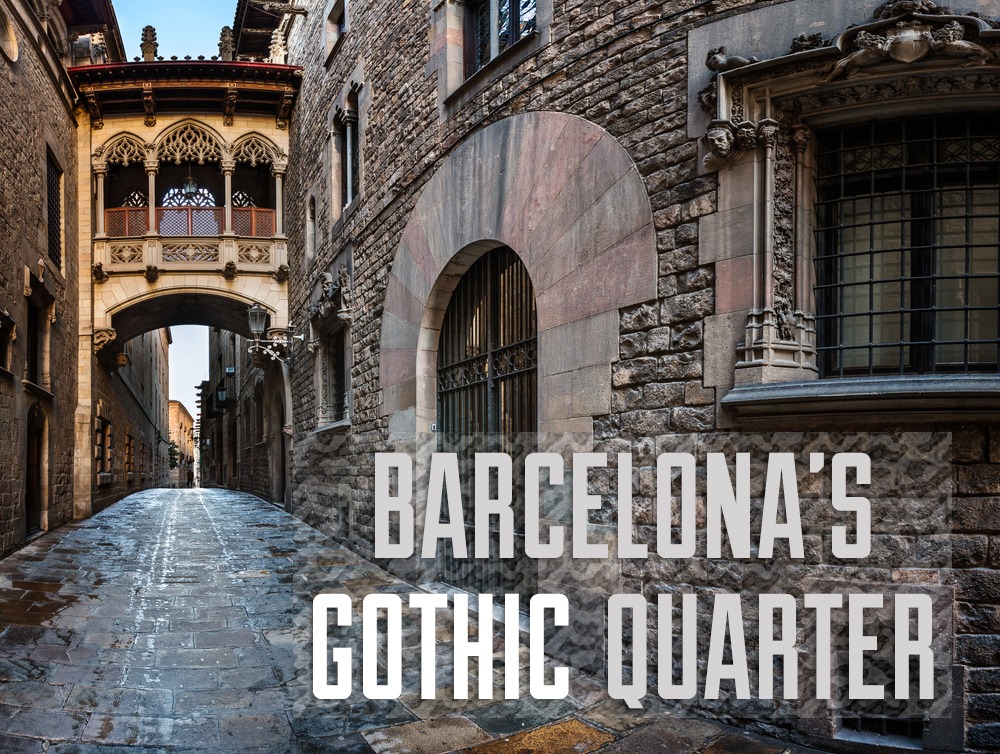
Gothic Quarter in Barcelona and its sights
Contents
- 1 History of Creation
- 2 Major Tourist Points
- 2.1 Plaza Nova
- 2.2 Cathedral
- 2.3 Jewish Quarter
- 2.4 Piazza San Jume
- 2.5 Historical Museum
- 2.6 Mares Museum
- 3 How to get to the Gothic Quarter?
The Gothic Quarter in Barcelona was named so relatively recently due to the fact that it contains many buildings made in the Gothic style. This quarter is difficult to pass without attention, for many tourists it is of interest. It is located in the center between Laietana Street and the Rambla, there is a multiple concentration of the city’s attractions and cozy restaurants and cafes.
Creation history
BC on the site of this quarter there was one of the Roman cities, which was surrounded by high walls to strengthen its position. Then all the buildings inherent in the Romans were built in it: aqueducts, baths, churches and a forum.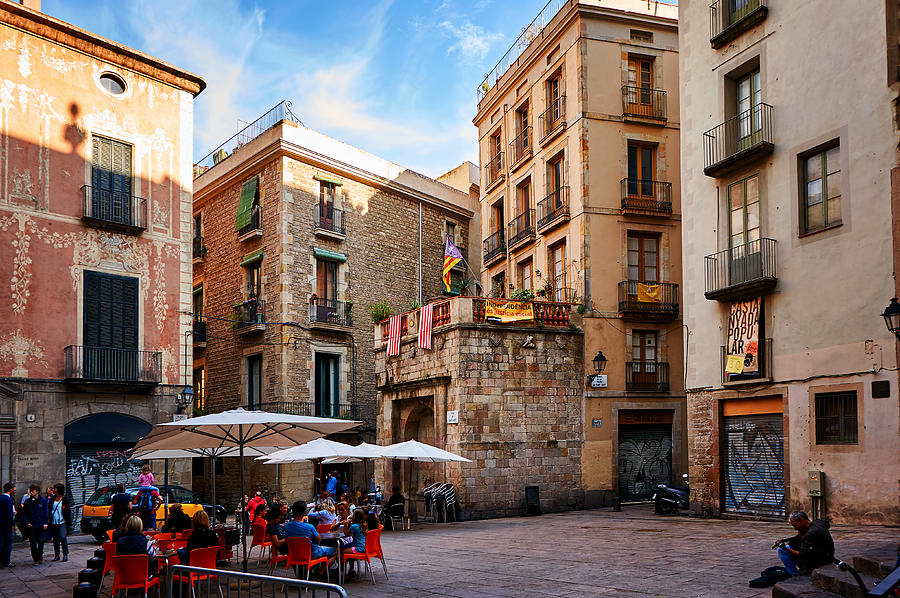
Interesting and unusual buildings in this quarter appeared in the 14th century, during the Renaissance no construction activities were carried out, which saved the already built buildings from destruction and new buildings. Thanks to this, you can now appreciate the majestic buildings in a gloomy Gothic style.
Major tourist destinations
The Gothic Quarter is bounded by Plaça Catalunya, Columbus Avenue and Via Laietana and the Rambla. On its northern side is the favorite place of the famous Pablo Picasso cafe “4 Cats”, it appeared in the quarter in the 19th century, and was built by analogy with the Parisian cabaret “Black Cat”.
Plaza Nova
It can be considered that the Gothic Quarter begins with it. The New Square was created in 1355 on the site of the city gates.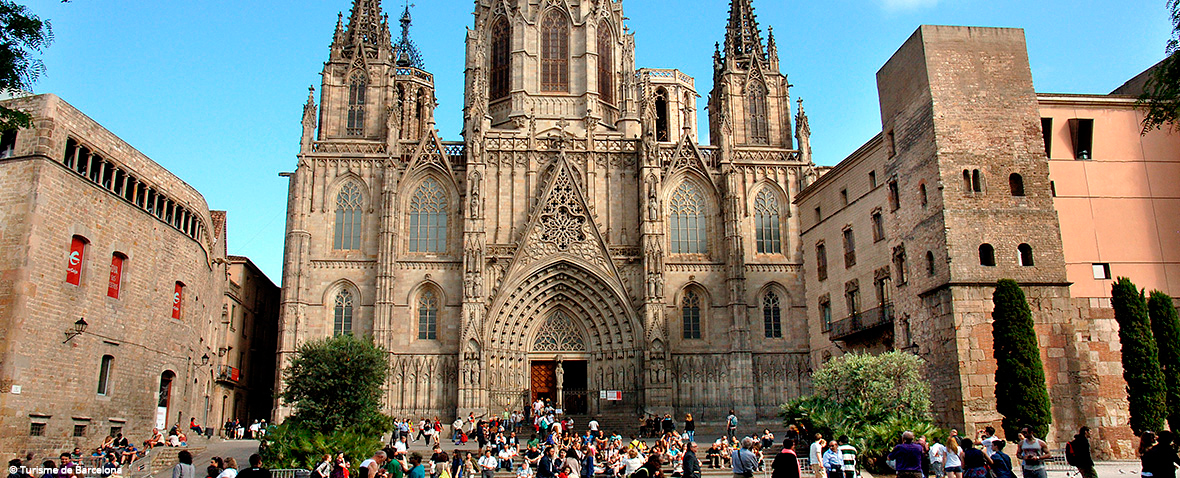
On the square, you can look at the Baroque Bishop’s Palace, whose façade is impressive.
His presence, as it were, acts as a contrast to the more modern building of the College of Architects. The latter building is notable for its large friezes, which Picasso himself worked on, but were brought to life by the Norwegian architect Carl Nesjar. The college was built in 1961.
The square is separated from the Cathedral by the house of the Archdeacon, one of its walls contains a fragment of the previously demolished fortress wall. In the 12th century, this building served as the residence of the entire church elite. The building was repeatedly reconstructed, its repair work was carried out at 16 and 19century, during the last alteration, the house was connected to a building adjacent to it.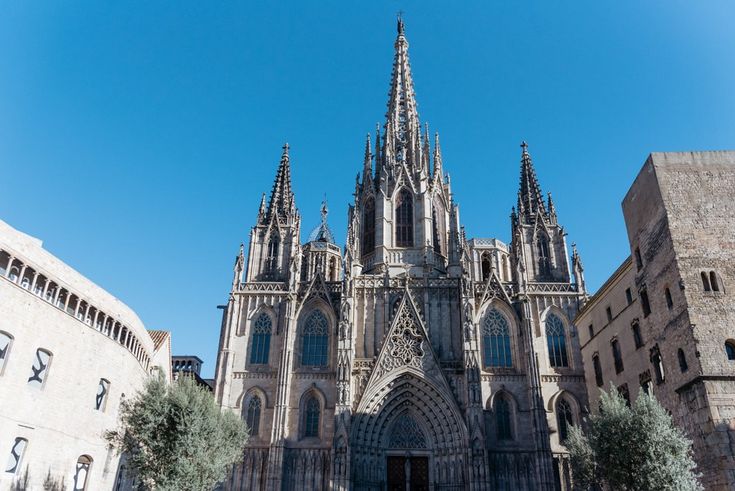
The central street of the Gothic quarter is Bishopskaya, it has a bridge that connects the House of Canons with the Government Palace. It was created by Joan Rubio and is considered to be the highlight of the Gothic area.
The House of the Canons is unlike any other building due to its unique and unusual layout. It was erected in the 15th century, the recent restoration helped to restore fragments of the interior that had been destroyed from time to time. One side of the building is directed to Carrer Paradis. On the same side are the ruins of an old Roman temple, which was previously erected in honor of Augustus.
This square has become the hallmark of the Gothic Quarter, it is the most popular, many tourists visit it every day. Many historical events have previously taken place on it, in addition, bright representatives of the Gothic style are gathered here.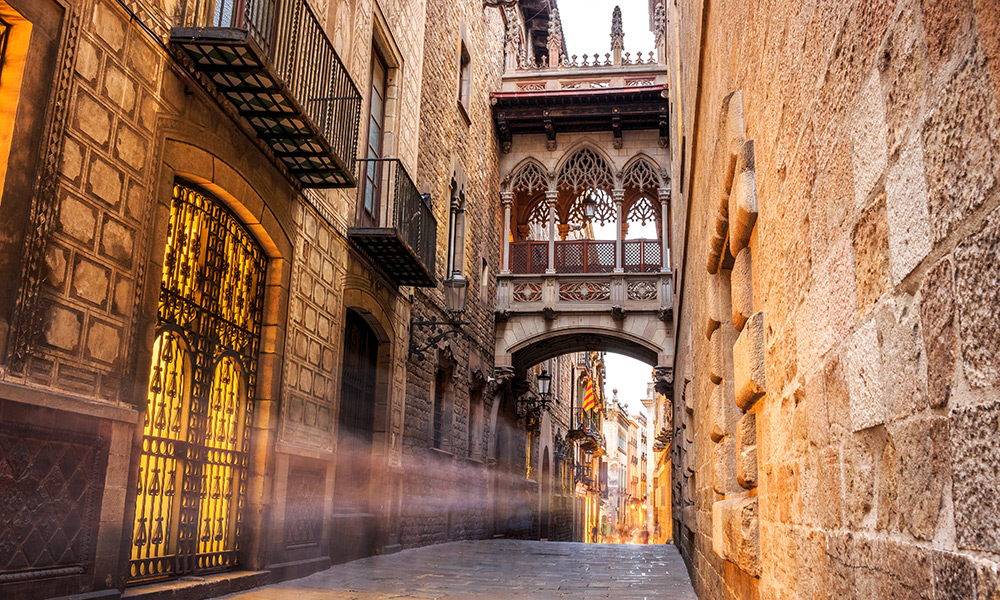
Cathedral
In the Gothic quarter, it occupies a special place, so important that the quarter itself is sometimes called “Cathedral” – this is its second, not the main name. The building of the cathedral impresses with its architecture, a huge stone structure is literally squeezed into a narrow space. The initial stage of its construction falls on the 13th century, but then its construction dragged on for several centuries. The facade of the cathedral was finally completed only at 19century. The cathedral building was erected in honor of Eupalia, who was elevated to the rank of saints in the 4th century, since a young girl of 13 years old was executed by pagans for her Christian faith. In the chapel at the cathedral, 13 white geese constantly live, which symbolize the purity of the martyr and her purity.
The building itself impresses with its power, its gothic-style towers go high into the sky, there are numerous arches on the facade, the walls are decorated with openwork ornaments.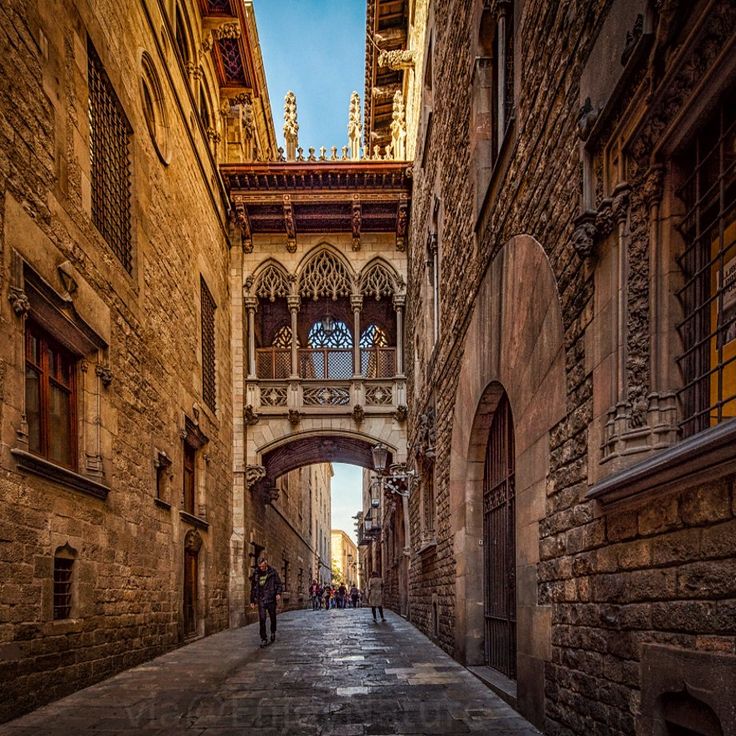
Read more about the Cathedral here.
Jewish Quarter
A whole milestone in history is hidden in the Jewish quarter. Earlier, back in the 13th century, the Jewish community occupying these lands was considered the richest, it lived according to its own laws and prospered. But after the expulsion of all the representatives of this people, led by Moses, everything became not so beautiful and fell into decay. But even now you can feel the spirit of the past, lost in the narrow and intricate streets of this quarter and feel the medieval atmosphere, as well as see some remnants of the former dawn of this area.
Now you can meet street virtuosos and musical actors, as well as visit numerous shops and shops with antiques.
Sant Jaume Square
This central area in the Gothic quarter is located at the intersection of the main streets of Barcino, it was created on the site of the former Roman forum. Square of St. Jacob is adorned by the city hall, as well as the Government House, near which there is a cozy courtyard with orange trees.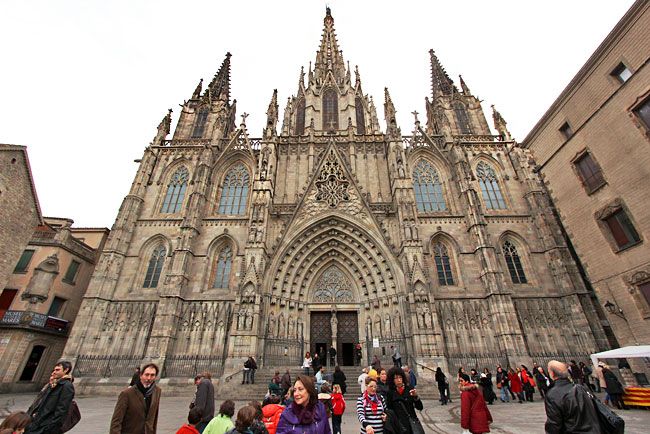
At this place, unusual competitions are held for the construction of castels – towers made of people. On Sundays, everyone here can learn how to dance the national dance – the sardana.
Historical Museum
He occupied the Clarian-Padellas House, this mansion was erected in the 15th century. The museum occupies 4,000 m 2 , right below the square, you can get acquainted with the exhibits of the history of the 1st century AD and trace the development of Barcelona to the 17th century.
The History Museum is located behind thick walls and has many courtyards. Some of them are difficult to find if you do not know exactly where they should be. Behind the glass showcases and mills, amazing artifacts are stored in the form of ancient dishes, fragments of historical buildings, their interiors and decorations.
The palace has a Throne Room, which serves as an excellent demonstration material for studying the Catalan Gothic of the late 14th century.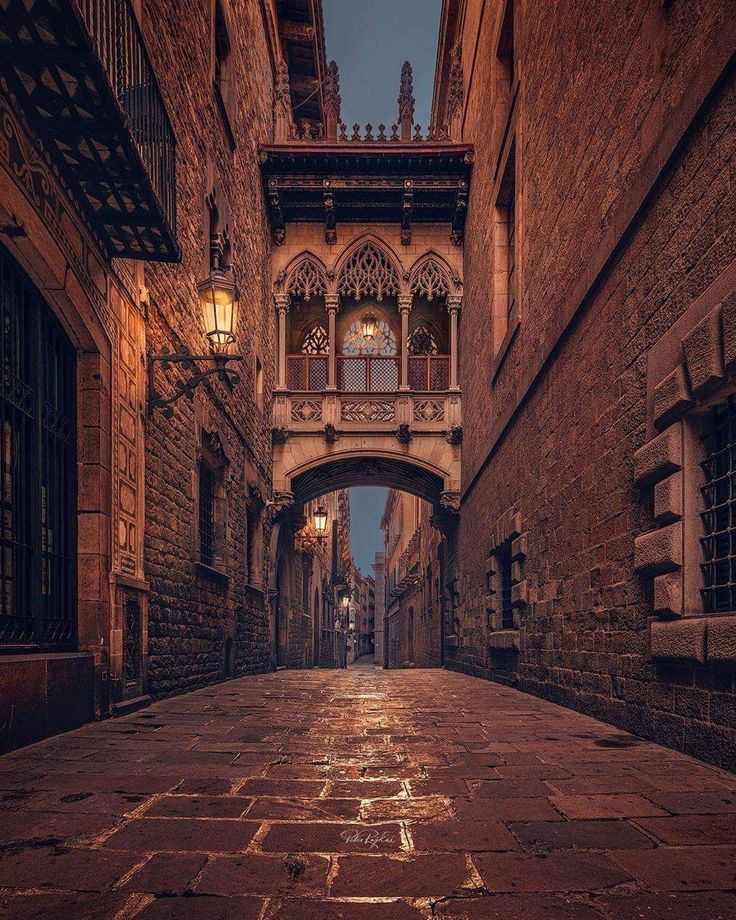
Mares Museum
It is often referred to as “Sentimental”, as most of its exhibits are sculptures of ancient Roman times, falling on the 20th century.
How to get to the Gothic Quarter?
It is located in the very center of the city, many roads lead to it, there is both overground and underground transport, you can also walk to it if you have a lot of free time. You can get there in the following ways:
- by tourist bus that runs on the red route, you must get off at the stop “Barri Gotic”;
- by city bus you can get to the same stop by taking route No. 59, 45, 40, 19, 17 and 14;
- by metro, you need to take the L3 line and get off at the Liceu or Drassanes station, and if you use the L4 line, you must not miss the Jaume I station.
If you want to walk around the Gothic Quarter, then plan it in advance, allocating as much time as possible.

You can book an exciting tour of the quarter here.
Gothic impresses everyone on the one hand with its majesty, and on the other hand with massiveness and gloom. But the Gothic quarter is notable for the fact that in it you can see not only this style, but also more modern ones, which allows you to significantly expand your horizons in one area and thoroughly study architecture. There is also an opportunity to visit cozy cafes with local cuisine, as well as buy souvenirs, please children with interesting and new toys. Look at street animators and listen to their fellow musicians, and if you wish, learn a traditional dance.
Gothic Quarter in Barcelona – Barcelona City Guide ТМ
Barcelona originates in the place of the Roman settlement “Barsino”. And the oldest part of the city is the Gothic Quarter in Barcelona. It is now extremely popular with tourists.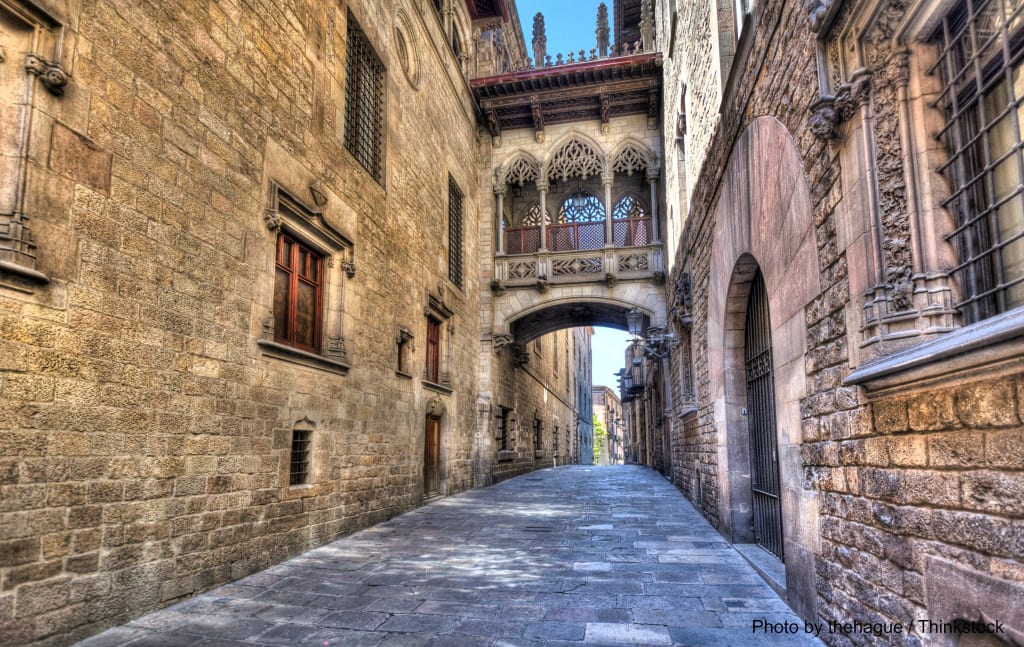
Go to on to book the best tour of Barcelona’s Gothic Quarter.
Historical sights of the Gothic Quarter in Barcelona
The Gothic Quarter has a beautiful architectural composition, which contributed to the restoration work. Gothic buildings are typical for any area of Barcelona, \u200b\u200bbut the Gothic Quarter got its name at the beginning of the last century.
1Plaza Nova
Plaza Nova (New Square) is considered the beginning of the Gothic Quarter. Previously, there was an entrance to the settlement “Barsino”.
Plaza Nova is considered to be the oldest square in Barcelona.
At one time there was an opportunity to buy and sell slaves.
Not far from Plaza Nova in Barcelona, you can see a pair of towers that have been preserved from the walls.
2 Bishop’s Palace
One of the main architectural sights of the Gothic Quarter in Barcelona is the Bishop’s Palace. It is located to the right of the towers. One of the creators of the frieze of the outer facade is Pablo Picasso himself. The heart of Barcelona’s Gothic Quarter is Bishop Street, which stretches all the way to Plaza de Sant Jaume.
This street in Barcelona is notable for the bridge that connects the Government Palace with the House of Canons. The bridge designed by Joan Rubio was created in 1926 and is considered one of the main architectural delights of the Gothic Quarter in Barcelona.
3House of the Canons – another Gothic Quarter in Barcelona
The House of the Canons was built in Barcelona in the 14th century and recently underwent restoration.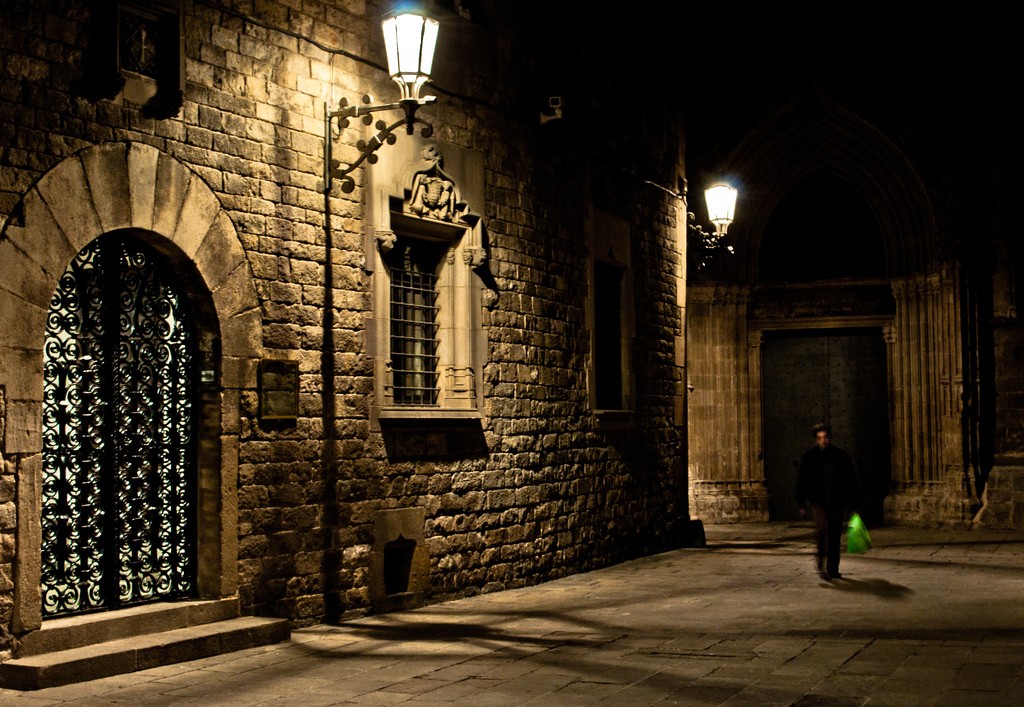
The Amazing House of the Canons is a large building in the Gothic Quarter with a very original layout.
One of the facades of the House overlooks the Carrer Paradis, which is famous for its medieval buildings, open to many visitors to Barcelona. Here are the remains of the Roman temple, which was dedicated to Augustus.
4 August columns
Columns of the Temple of Augustus in Barcelona
A characteristic feature of the temple in the Gothic Quarter are 4 grandiose Corinthian columns. The temple was built on the highest point of the Roman colony. It is enough to cross a narrow lane along Carrer del Bizbe Irurita in Barcelona, and the tourist will find himself in Plaza de San Felip Neri. This street of the Gothic Quarter is characterized by a small square and the Church of San Felip Neri, built in the 18th century. In the immediate vicinity is the Museum of the History of Shoes.
The number of attractions in Barcelona in the Gothic quarter allows it to be considered the leader in the number of architectural masterpieces of the Gothic style in Europe.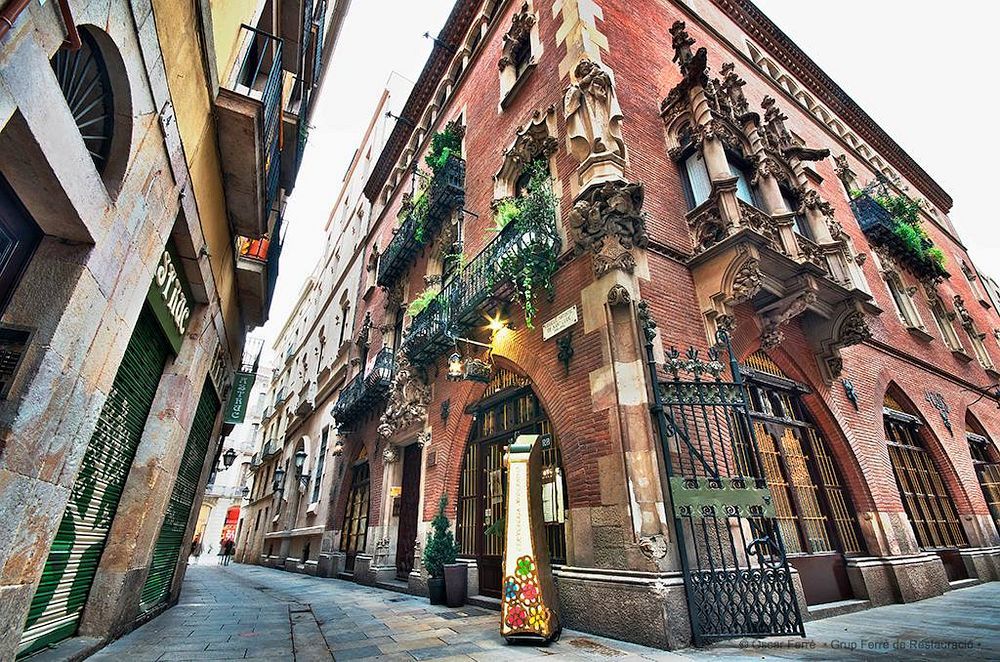
The best tours in the Gothic Quarter
The best attractions in the Gothic Quarter in Barcelona
5Barcelona Cathedral
The outstanding façade and the general sophistication of architectural forms make the Cathedral the main attraction of the Gothic Quarter in Barcelona. Inside the cathedral there is a courtyard in which 13 snow-white geese live.
The inhabitants of Barcelona believe that their color symbolizes the purity of Saint Eulalia, who was killed by pagans at the age of 13. This fact is connected with the number of geese inside the cathedral.
6King’s Palace in Barcelona
Grand Royal Palace of Barcelona
The Gothic Quarter is famous for the presence of a number of medieval buildings that served as the residence of monarchs for five hundred years.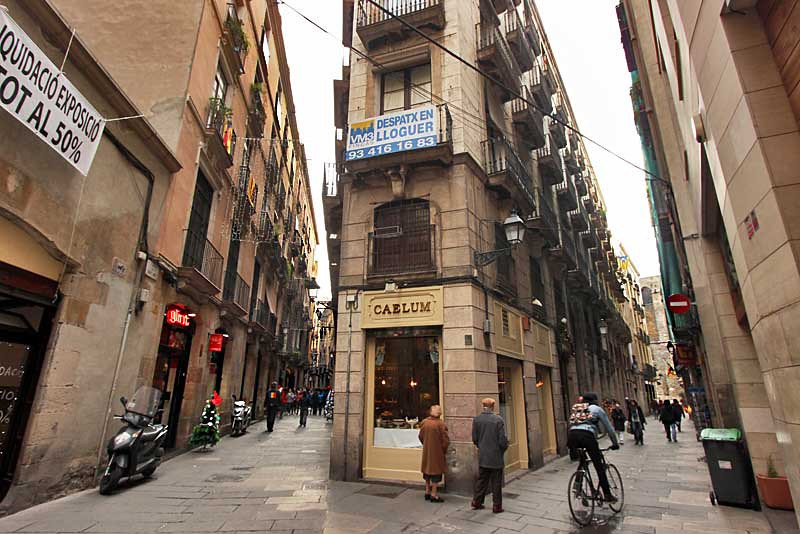
According to the source, King Fernando met Christopher Columbus at the Plaza Reial in Barcelona after completing his fateful journey to the Americas.
The Royal Palace of Barcelona, built in the 13th century, was built as a residence for the counts. Then many meetings of the Holy Tribunal were organized here.
7Buildings of the City Hall and Government of Catalonia in the Gothic Quarter
Barcelona’s Gothic Quarter has been chosen as the location for the city hall and government of Catalonia. Over the years, the city hall building has undergone changes, but elements of the Gothic decor with the coat of arms of Barcelona are still available for visitors to appreciate.
The entrance to the city hall is decorated with a monument to Jaume I, the founder of the Barcelona city council, and J. Fivelier, who obliged the city’s elite to pay taxes.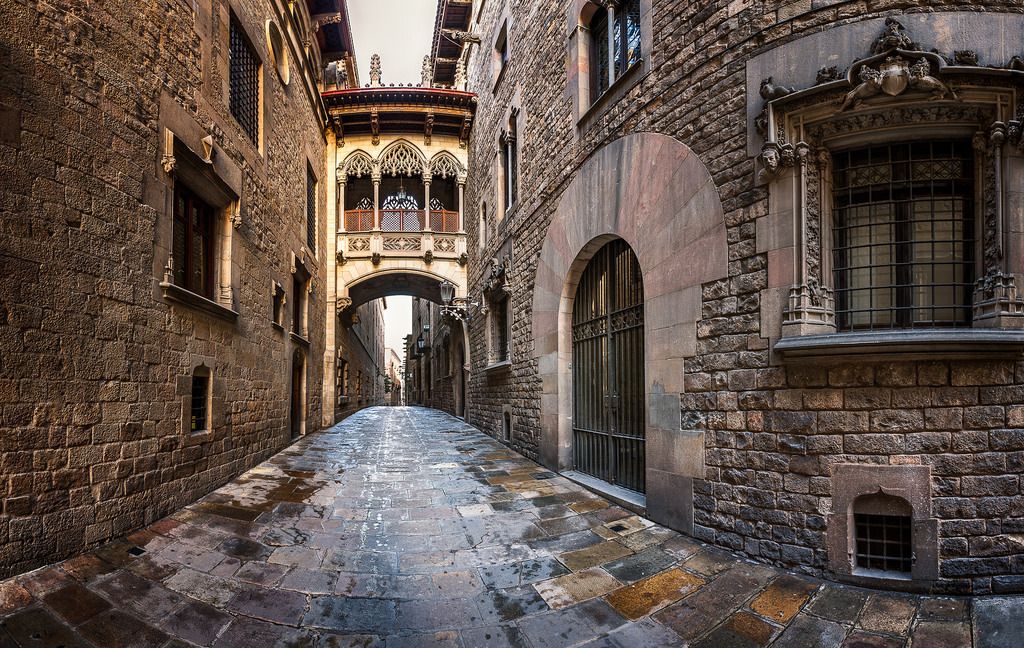
The chapel of Sant Jordi and the 16th century bell tower, the exquisite orange courtyard, which give a unique charm to the Gothic Quarter in Barcelona, deserve special mention.
8 Canon House and Archdeacon House
Since the 11th century, only one building has survived in the Gothic Quarter – the Canon’s House. He became famous for the fact that dinners for the poor were organized within its walls, and then the house was transferred to the property of the clergyman of the Cathedral. Currently, the house of the canon in the Gothic quarter serves as the residence of the President of Catalonia.
The House of the Archdeacon (Casa del Ardiaca) was erected on the foundations of a 12th-century building. At the gate of this house there is a mailbox with images of swallows and turtles:
- The first symbolizes the hope of getting a quick answer.
- Second – the rate of delivery of sent letters.
The Gothic Quarter in Barcelona is famous for the museums of the sculptor Frederic Mares and the history of the city.
Are you going to Barcelona? Don’t forget to buy tickets to local attractions to avoid queues. You can do this at the link on the official ticket platform.
Gothic Quarter in Barcelona on the city map
- How to avoid queues at Barcelona attractions. Tickets for the Sagrada Familia and Park Güell skip the line.
- How not to be deceived by local taxi drivers. Order a taxi in advance with fixed rates online. The most reliable service for ordering a taxi is KiwiTaxi .
-
Excursions in Barcelona with locals will help you get to know this city for real. The best way to get comfortable in an unfamiliar city is to walk around it with a person who has lived here for many years.


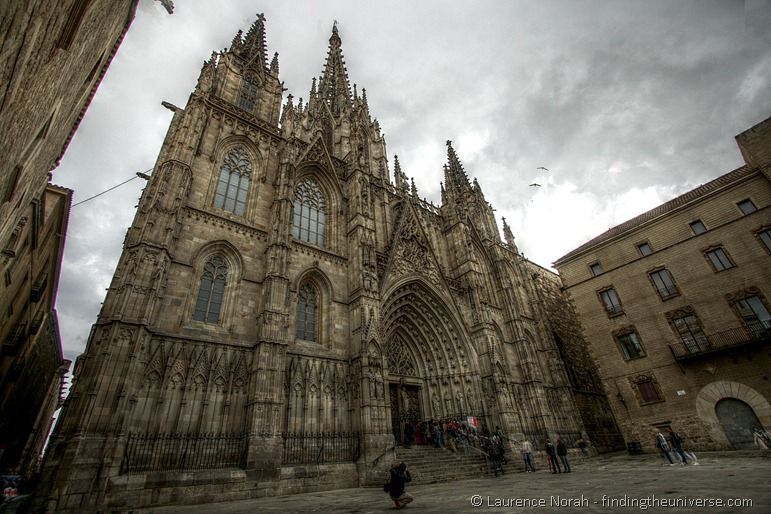 At one time there was an opportunity to buy and sell slaves.
At one time there was an opportunity to buy and sell slaves. 
